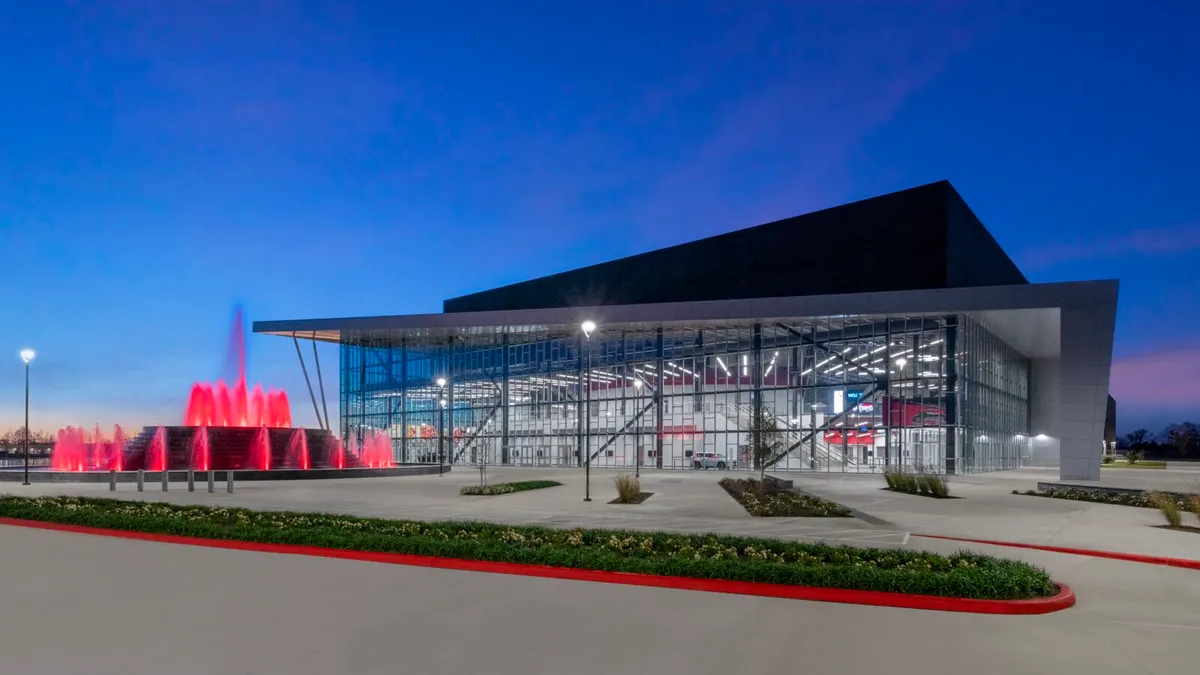A lot of money goes into the creation of new sports venues, and not just for pro teams.
In recent years, stadium construction has evolved to focus more on cultivating the game day experience. Some multibillion-dollar projects break ground, as existing venues get renovations. Both kinds of projects see expansions that include massive new video screens, improved seating or suites and concourses to provide more amenities to fans.
That evolution is coming for more than just the highest level of professional sports, according to Michael Hessert, senior principal with PBK Sports. It’s the athletic arm of Houston-based architecture firm PBK, which has designed projects for multiple types of sports teams — such as football, swimming and softball — at schools including the University of Texas, Texas A&M and the University of Houston.
Here, Hessert talks with Construction Dive about how stadium design is changing and why general admission seats may be less common in the future.
The following has been edited for brevity and clarity.
CONSTRUCTION DIVE: In your experience, what’s the difference between constructing a professional sports venue versus a stadium on a college campus?
MICHAEL HESSERT: Not too long ago, I'd say the difference was pretty stark. You have a higher level of expectation from the fan base in a professional venue. But I think those lines are becoming very blurred. It's a top-down arms race, and we see it in our business.

Trends and expectations from a more sophisticated fan base are making their way from professional into collegiate through the various levels of collegiate athletics from DI, DII, DIII, junior college and even on down into secondary education. We're seeing stuff in our K-12 practice that we wouldn't have seen five, 10 years ago.
For K-12, we see more focus on athlete nutrition recovery, strength and conditioning development, but also on the expectation of the spectator and the fan. It really is all about bigger video boards, better sound systems, variation in seating types for all levels.
It could be a function that we're in Texas where football is king, but we see it across multiple building types, whether it be stadiums or ballparks or arenas. It's just a much more sophisticated fan base, and they're used to — whether it be in person or on TV — seeing certain things. Fans have come to expect those at pretty much every event they go to.
How has design evolved to boost that fan experience?
I think what you're seeing now is a much broader diversity in amenities and what I'll call "properties" within a venue. Take seating types. In the good old days 20 years ago, you would have a lower bowl, you would have clubs, you would have suites and then you'd have upper seating in the nosebleed sections.
Nowadays you've got courtside seats, courtside lounges, all manner of suites and clubs and different types of amenities that give a broad diversity of fans an experience.
And it's all about revenue generation. Whereas before you may have had four categories that were stacked vertically from lower cost to higher cost, the more layers that you can put in there now, the more you can drive the revenue dollar into a higher bracket and increase your revenue stream without adding more seats.
I think there's going to be a trend. What you're going to see is a reduction in seat quantity in order to provide different types of seating. So owners will voluntarily reduce the number of seats that their facility can hold in order to increase the revenue stream by offering more amenities and a broader diversity of experiences.
Are you seeing more renovations of venues that want to catch up and get those amenities?
I think so. I think those that have the geometry or the backbone to be able to support that within their existing structure, for sure, I think you're going to see that. Because it's cheaper in many ways to renovate something that you already own or are paying off versus going out and building something new, especially in the pro market where you're talking a billion dollars and up for new facilities.
Pivoting back to construction for schools, are there opportunities for builders looking to get into stadium building at each level?
You know, we just finished within the last two or three years, a 10,000-seat football stadium here in Texas, that the master plan is to be expandable to 15,000 seats. And it rivals anything you would find at a DII, DIII, junior college level and probably rivals some Division I, too. So projects like that are pulling in the bigger contractors: Gilbane, Manhattan, those kind of folks.
I think you're seeing that contractors who used to be working at the professional level are coming down into the collegiate and the secondary market along with the projects, because the projects are getting to a certain size that it is worth their attention and expertise to deliver.
What else should contractors know about the sector?
Name, image and likeness rules and the transfer portal are changing the paradigm of collegiate athletics. Collegiate athletics is in the process of transitioning from an amateur environment to a semi-professional one. This change has a broad impact on athletic departments, but specifically on the recruiting and retention of athletes. The ease with which athletes can now move from program to program, seeking greater personal brand recognition and revenue, has placed coaches and athletic directors in an unfamiliar environment.
One of the areas of impact is the former models of recruiting and retention, namely facilities. While there has always been pressure and a need to evolve and improve facilities, this is now accelerated and amplified. To be competitive in recruiting and retaining premier collegiate athletes, programs need to provide ‘big stages’ for their athletes to perform. Similar to the ‘stage’ or competition venue is all of the support facilities and services such as student success centers, nutrition, sports medicine, training and performance centers, locker rooms, and more that provide an environment of excellence. The need to improve the environment of the student-athlete is much greater.
In addition, I think what you're going to see is a broader diversity or a new avenue for getting projects funded and built, whether that be public-private partnerships or equity groups coming in.
In the past you could expect to have an owner and a contractor or even a program manager. But now I think you're going to have developers coming in and just more parties to the contract and the process.




















